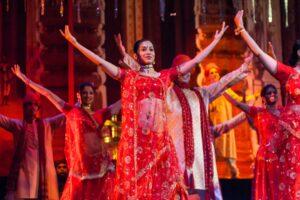Fodor's Expert Review Elephanta Caves
A quick 30-minute ferry ride from bustling South Mumbai, the UNESCO World Heritage site Elephanta Caves make an ideal half-day trip for anyone who wants a quick glimpse of India's ancient history. Once you arrive at the island, you climb a steep hill, on rough-hewn steps, past trinket sellers and beggars, to get to Shiva Cave; greenery abounds. The temple, carved out of the basalt hillside, is 130 square feet. Inside, each wall has elaborate, 16-foot-tall rock carvings of Lord Shiva, the destroyer, in his many forms, depicting famous events from the Hindu epics. The main sculptures are on the south wall, at the back.
The central recess has the most outstanding sculpture, the unusual Mahesamurti, the Great Lord Shiva—an 18-foot triple image. Its three faces represent three aspects of Shiva: the creator (on the right), the preserver (in the center), and the destroyer (on the left). Other sculptures near the doorways and on side panels show Shiva's usefulness. Shiva... READ MORE
A quick 30-minute ferry ride from bustling South Mumbai, the UNESCO World Heritage site Elephanta Caves make an ideal half-day trip for anyone who wants a quick glimpse of India's ancient history. Once you arrive at the island, you climb a steep hill, on rough-hewn steps, past trinket sellers and beggars, to get to Shiva Cave; greenery abounds. The temple, carved out of the basalt hillside, is 130 square feet. Inside, each wall has elaborate, 16-foot-tall rock carvings of Lord Shiva, the destroyer, in his many forms, depicting famous events from the Hindu epics. The main sculptures are on the south wall, at the back.
The central recess has the most outstanding sculpture, the unusual Mahesamurti, the Great Lord Shiva—an 18-foot triple image. Its three faces represent three aspects of Shiva: the creator (on the right), the preserver (in the center), and the destroyer (on the left). Other sculptures near the doorways and on side panels show Shiva's usefulness. Shiva brought the Ganges River down to Earth, the story says, letting it trickle through his matted hair. He is also depicted as Yogisvara, lord of yogis, seated on a lotus, and as Nataraja, the many-armed cosmic dancer. The beauty of this stonework lies in the grace, balance, and sense of peace conveyed in spite of the subject's multiple actions. It's all very peaceful and serene. Then you step back outside and see the monkeys.
They are everywhere: climbing trees, hooting and hollering, looking for opportunities to get any human food you might be carrying—so we suggest you don't bring any with you (have lunch before you leave Mumbai, or wait until you get back). There are so many monkeys, and they are so comfortable around humans, that they almost distract you from the 1,500-year-old rock carvings. Almost.
It's unclear who did the carvings on Elephanta, but it is known that the island was originally called Gharapuri; the Portuguese renamed it after a large stone elephant was found near where their boat landed (the figure collapsed in 1814 and is now in mainland Mumbai's Victoria Gardens, also known as Jijamata Udyaan). Shortly before the temples were created, Mumbai experienced the golden age of the late Guptas, under whom artists had relatively free range. The Sanskrit language had been finely polished, and under the court's liberal patronage writers had helped incite a revival of Hindu beliefs. It was Shivaism—the worship of Shiva—that inspired the building of these temples.
The MTDC leads a tour, every day at 2 pm (book when you arrive), that is good but not essential, and runs a tiny restaurant on the island for refreshments and beer. In February a dance festival is held here.
Getting here: ferries for the one-hour trip (each way) depart daily every half hour from 9 to 2 from the Gateway of India and from noon to 5 from Elephanta Island every half hour, unless the sea is very choppy---don't visit Elephanta during monsoon season. You pay for your ferry and cave tickets separately.
READ LESS






